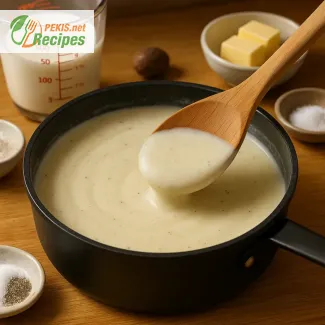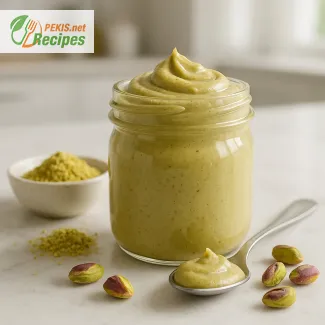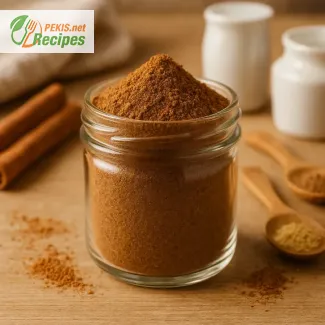
The Authentic Taste of Homemade White Sauce
A timeless foundation in Italian and French cuisine
Silky, rich, and irresistibly smooth, bechamel sauce—known in Italy as besciamella—has long been a staple of European cooking. This creamy white sauce, simple in ingredients yet refined in technique, forms the culinary backbone of countless dishes, from lasagna to croque monsieur, from moussaka to gratin dauphinois. Its versatility and unmistakable texture have made it one of the mother sauces of classical cuisine, particularly in Italian and French cooking traditions.
Unlike more elaborate sauces that rely on lengthy simmering or complex reductions, bechamel is a masterpiece of minimalism. Just butter, flour, and milk, when combined with proper technique and care, transform into a base that elevates both humble and sophisticated meals. It is the kind of sauce that quietly carries a dish—never dominating, but always essential.
How bechamel evolved across European kitchens
The origins of besciamella are often attributed to French chef Louis de Béchamel, but the Italians, particularly in the Emilia-Romagna region, embraced and refined it to fit their own culinary identity. In Italian kitchens, besciamella is treated not just as a sauce but as a building block for layered pasta, stuffed vegetables, and oven-baked casseroles.
Over time, this sauce transcended borders and adapted to regional variations. In Greek cuisine, it appears atop pastitsio with a hint of nutmeg. In Spanish cooking, it forms the creamy filling for croquetas. Yet despite these cultural shifts, the essence of bechamel remains the same: a velvety, mild, and perfectly neutral canvas for flavor.
The secret to achieving perfect texture and flavor
Making authentic bechamel at home requires more than just following a recipe. The secret lies in the balance between roux and milk, the timing of the whisking, and the gentle infusion of aromatics. A classic version starts by cooking equal parts butter and flour into a roux, which is then slowly whisked with warm milk to prevent lumps.
A touch of salt, a dash of white pepper, and often a grating of nutmeg bring the sauce to life. For those aiming for a richer profile, the addition of cream or grated Parmigiano-Reggiano can turn it into a variation known as mornay sauce—another classic in its own right.
Key dishes that depend on classic bechamel
Some of the world’s most beloved comfort foods would simply not exist without besciamella. Lasagna alla Bolognese depends on the creamy layering of bechamel between pasta sheets and ragù. Macaroni and cheese, particularly in its European-style versions, relies on a proper white sauce as a base before cheese is added.
Vegetable gratins, chicken pot pies, and baked cannelloni all gain richness and cohesion thanks to this unassuming sauce. It binds ingredients, offers moisture during baking, and develops a delicate crust that brings texture and depth.
Variations and modern uses of besciamella
While the traditional method remains unmatched in flavor and consistency, modern kitchens have introduced adaptations for various dietary needs. Plant-based cooks often replace butter with olive oil or vegan margarine, and use almond or soy milk as substitutes. Gluten-free versions swap wheat flour for rice flour or cornstarch to maintain the essential thickness.
Contemporary chefs also infuse the milk with onion, bay leaf, or clove before adding it to the roux, creating deeper aromatic profiles. Some enrich it with mustard, cheese, or truffle oil, depending on the dish it accompanies. These tweaks honor the original while opening the door to creative exploration.
Why every cook should master bechamel
Bechamel sauce is more than just a recipe—it’s a rite of passage in mastering classic technique. It teaches the fundamentals of roux preparation, temperature control, and flavor layering. Once perfected, this sauce becomes a go-to for countless dishes and unlocks confidence in sauce-making as a whole.
Whether you’re preparing a traditional Italian lasagna, a decadent soufflé, or simply want to elevate steamed vegetables, mastering besciamella gives you control over texture, flavor, and presentation. Its simplicity is deceptive; within three ingredients lies the ability to transform everyday cooking into something extraordinary.
- Heat the milk: In a small saucepan, gently warm the milk (500 ml / 2 cups) over low heat. Do not boil—just bring it to a slight simmer and keep it warm.
- Make the roux: In a separate heavy-bottomed saucepan, melt the butter (50 g / 3.5 tbsp) over medium heat. Once fully melted, add the flour (50 g / ⅓ cup) and whisk continuously for about 2–3 minutes, until the mixture becomes golden and smells slightly nutty. This is your roux.
- Add warm milk slowly: Gradually pour the warm milk into the roux in a steady stream, whisking constantly to prevent lumps. Start with a small amount and incorporate fully before adding the rest.
- Simmer and thicken: Once all the milk is added, bring the mixture to a gentle boil, then reduce the heat to low and cook for another 8–10 minutes. Continue stirring until the sauce thickens to a velvety, smooth consistency.
- Season the sauce: Stir in the salt (1 g / ¼ tsp), white pepper (0.5 g / 1/8 tsp), and a pinch of nutmeg (0.5 g / 1/8 tsp). Cook for an additional 1–2 minutes, then remove from heat.
- Use immediately or store: The sauce is now ready to use in lasagna, gratins, cannelloni, or vegetable casseroles. If storing, let it cool slightly and cover with plastic wrap directly on the surface to prevent a skin from forming.
Mastering Besciamella: Elevating the Classic White Sauce
Smart enhancements and expert tricks for deeper flavor and texture
While the traditional bechamel sauce relies on a simple trio of butter, flour, and milk, its elegance lies in the technique, not just the ingredients. Still, there are several subtle ways to enhance the flavor, improve the texture, and even boost the nutritional profile of this timeless classic. By understanding its chemistry and culinary role, home cooks can transform it from a basic element into a rich, velvety, and aromatic star of the dish.
The role of aromatics and infused milk
One of the most effective ways to add depth to the flavor is by infusing the milk before incorporating it into the roux. Gently warming the milk with bay leaf, a clove-studded onion, or a piece of celery can create a subtle but complex aromatic base. Letting these aromatics steep for 10–15 minutes imparts a fragrant layer that elevates even the simplest recipes like lasagna, croquettes, or vegetable gratins.
Adding a small piece of garlic or a dash of thyme can steer the sauce toward more Mediterranean profiles, while a hint of mustard or curry powder gives it a modern twist suited for fusion cuisine.
The effect of cheese and how to balance it
Adding grated Parmigiano-Reggiano, Gruyère, or sharp cheddar transforms classic bechamel into Mornay sauce. While this enhances umami and richness, it’s essential to balance saltiness, as some cheeses carry a significant sodium load. The cheese should be added at the end of cooking, once the heat is reduced, to avoid separation or graininess.
For a smoother finish, opt for finely grated cheese and stir slowly in a figure-eight motion rather than brisk whisking. This helps emulsify the sauce gently and enhances the creamy texture without overwhelming the base flavor.
Why homemade bechamel is superior
Store-bought white sauces often contain preservatives, artificial thickeners, or excessive salt and fat. In contrast, a homemade version allows full control over the quality of ingredients, sodium levels, and consistency. Freshly made bechamel has a richer mouthfeel, cleaner flavor, and adapts seamlessly to the specific needs of the dish it supports.
Moreover, the sensory impact of homemade sauce—its aroma, its silky texture, and the way it bonds with other components in the oven—cannot be replicated by mass-produced alternatives.
Common mistakes to avoid when preparing bechamel
One of the most frequent mistakes is cooking the roux too little or too much. An undercooked roux will leave a raw flour taste, while an overcooked one may lose its thickening power or turn too dark, altering the sauce’s pale color and neutral profile.
Another pitfall is adding cold milk to the roux, which leads to lumping. Using warm milk and adding it gradually with continuous whisking is key. Skipping the whisk and using a spoon can also compromise the smoothness.
Cooking too quickly at high heat can scorch the milk or split the butter. Maintaining a low to medium heat ensures a controlled thickening process and preserves the flavor integrity.
Lighter and healthier alternatives
To create a lighter version of the sauce without sacrificing too much creaminess:
- Use low-fat or semi-skimmed milk instead of whole milk.
- Replace butter with extra virgin olive oil or light vegan margarine to reduce saturated fat.
- Use whole wheat flour or oat flour for a slightly nutty flavor and added fiber.
For gluten-free diets, cornstarch or rice flour can be used in place of wheat flour. These starches create a slightly different texture—glossier and less elastic—but still deliver a luxurious consistency when handled correctly.
Plant-based milks like unsweetened almond, soy, or oat milk can be used as alternatives, but they must be unflavored and unsweetened to avoid clashing with savory dishes.
Texture tricks for professional results
If a particularly silky finish is desired, strain the finished sauce through a fine-mesh sieve to remove any remaining lumps or undissolved particles. Letting the sauce rest for a few minutes before use allows it to settle and thicken naturally, making it easier to spread or pour depending on its application.
To avoid the formation of a skin during cooling, cover the surface directly with parchment paper or plastic wrap touching the sauce. Reheating should be done gently over low heat, possibly with a splash of warm milk to loosen the consistency.
Expanding its use beyond traditional dishes
Although lasagna and gratin dishes are classic pairings, bechamel also works beautifully as a binding sauce for vegetable pies, in stuffed crêpes, or even as a base for white pizza with mushrooms and truffle oil. Its ability to carry and bind flavors makes it a versatile component in both traditional and modern cooking.
By experimenting with seasonal herbs, nut oils, or even finishing with a swirl of pesto or spiced butter, the bechamel base can become a unique signature of a chef’s personal style.
Allergens present in the recipe:
- Milk (in both milk and butter)
- Gluten (in flour)
Tips to eliminate allergens and gluten:
- Replace cow’s milk with unsweetened almond milk or oat milk for a dairy-free version.
- Substitute butter with plant-based margarine or olive oil.
- Use gluten-free flour (e.g., rice flour or a certified gluten-free blend) to make it gluten-free.
Vitamins and minerals per serving (approximate):
- Calcium: 180 mg – Supports bone health and muscle function.
- Vitamin D: 0.7 µg – Aids in calcium absorption and immune support.
- Vitamin A: 160 µg – Essential for vision, skin health, and immunity.
- Phosphorus: 120 mg – Important for energy production and bone structure.
- Vitamin B12: 0.5 µg – Supports red blood cell formation and brain function.
Antioxidants per serving (approximate):
- Vitamin A (retinol): 160 µg – Antioxidant that protects cell membranes.
- Selenium: 3 µg – Contributes to defense against oxidative stress.





